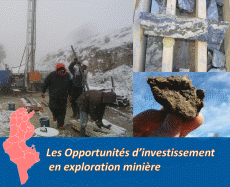| Programme annuel & rapport de suivi technique |
-

Rapport d'activités 2023
-

Programmes Techniques 2024
|
| Géocatalogue |

|
| Appels d'Offres |
-

ACQUISITION DES TICKETS RESTAURANT POUR LE PERSONNEL DE L’ONM
-

CHOIX D’UNE COMPAGNIE D’ASSURANCE
-

ACQUISITION ET MISE EN ŒUVRE D’UN PROGICIEL DE GESTION INTEGRE
|
|
Investir en Tunisie |


|
|
|
|
|
::
Documentation and Editions
>>
Research library
|
| |
|
[
Search by author
]
[
Search keyword
]
[
Search by index
]
[
Search by category
]
|
title of the reference :
|
The Permo-Triassic of southern Tunisia - Biostratigraphy and palaeoenvironment
|
|
Publication Date:
|
1990
|
|
Author :
|
Kilani-Mazraoui F., Gargouri Razgallah Saloua, Tayech Mannai Beya
|
|
Catalogue type :
|
Livre
|
|
Catalogue reference :
|
(NLD) Rev. Palaeobot. Palynol. The Permo-Triassic of southern Tunisia - Biostratigraphy and palaeoenvironment Le Permo-Trias de la partie sud de la Tunisie. Biostratigraphie et paléoenvironnement Internatl. Symp. on Circum-Mediterranean Palynology The Upper Permian of Southern Tunisia, the only marine outcrop known in Africa, is characterized by four sedimentary sequences: (a)a basal unit represented by sandy shaly deposits with marine fauna: (b)a unit of carbonate sediments: (c)a shaly unit: and (d)an uppermost unit represented by sandy shaly deposits. This present study is mainly based on data from two wells drilled in the area to the south of the outcrop sections. Combined palynological and micropaleontological evidence allow the recognition of the Permo-Triassic boundary, the proposal of a biostratigraphic model of the different Triassic units and the reconstruction of the paleoenvironmental history. An important disconformity (stratigraphic uncomformity)has been demonstrated at the Early Scythian level: it is marked by the absence of part of both the Upper Permian and Lower Scythian. This phenomenon seems to be widespread. It has been reported in the Middle East, in Libya and has been found for the first time in Tunisia. From the north to the south, the sedimentation varies laterally in both lithology and thickness: in the north, the sediments are calcareous while in the south t
Shale ; Discordance ; Roche clastique ; Roche sédimentaire ; Permien supérieur ; Trias inférieur ; Paléoenvironnement ; Limite stratigraphique ; Palynomorphe ; Milieu lagunaire ; Faune foraminifère ; Taxon benthique ; Milieu eau peu profonde ; Tunisie ; Sebkha Gargouri Razgallah Saloua Tayech Mannai Beya Kilani-Mazraoui F. Stratigraphie, Paléontologie
|
|
Indexation decimale :
|
Stratigraphie, Paléontologie
|
|
Keywords :
|
Shale ; Discordance ; Roche clastique ; Roche sédimentaire ; Permien supérieur ; Trias inférieur ; Paléoenvironnement ; Limite stratigraphique ; Palynomorphe ; Milieu lagunaire ; Faune foraminifère ; Taxon benthique ; Milieu eau peu profonde ; Tunisie ; Sebkha
|
|
Summary :
|
The Upper Permian of Southern Tunisia, the only marine outcrop known in Africa, is characterized by four sedimentary sequences: (a)a basal unit represented by sandy shaly deposits with marine fauna: (b)a unit of carbonate sediments: (c)a shaly unit: and (d)an uppermost unit represented by sandy shaly deposits. This present study is mainly based on data from two wells drilled in the area to the south of the outcrop sections. Combined palynological and micropaleontological evidence allow the recognition of the Permo-Triassic boundary, the proposal of a biostratigraphic model of the different Triassic units and the reconstruction of the paleoenvironmental history. An important disconformity (stratigraphic uncomformity)has been demonstrated at the Early Scythian level: it is marked by the absence of part of both the Upper Permian and Lower Scythian. This phenomenon seems to be widespread. It has been reported in the Middle East, in Libya and has been found for the first time in Tunisia. From the north to the south, the sedimentation varies laterally in both lithology and thickness: in the north, the sediments are calcareous while in the south t
|
|
Exemplaries :
|
-
|
|
|
|
|
|
|
|



